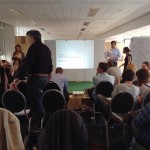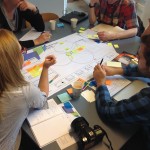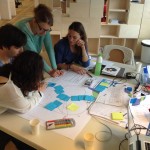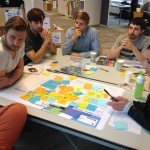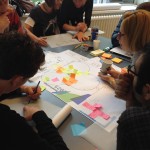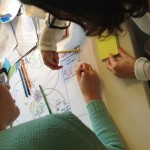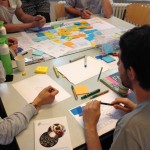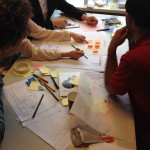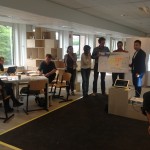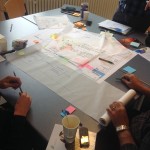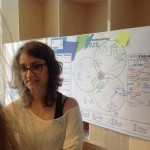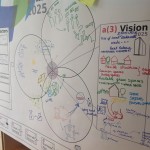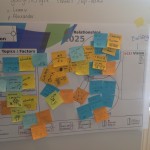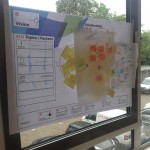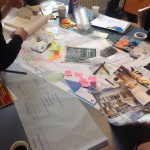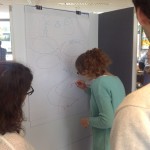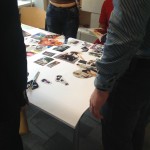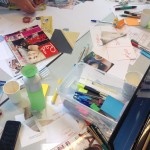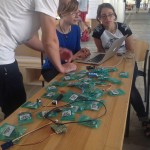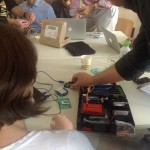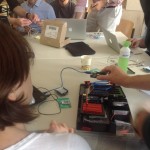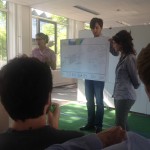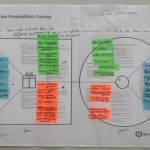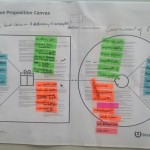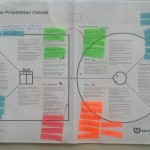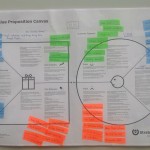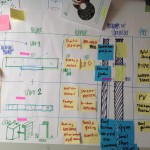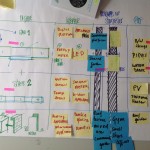Blog
Visioning the future built environment
Workshop visioning the future built environment as part of Climate-KIC Summer School
- Problem owner: Climate-KIC
- Process owners:
- Facilitators: Susie Brand-de Groot, Jan-Willem Hoftijzer, and Ricardo Mejia (ID Studio Lab, Delft University of Technology)
- Participants: Ph.D.’s, postdocs, Master students and driven professional.
- Place & Date: PlaySpace Rotterdam, July 8th, 2014.
Challenge
Complex topics like urbanization and energy management need special commitment in unifying a common view, especially due to the amount of parties co-designing and co-producing products and services for its development. This requires collaboration across departments and partnering companies and is connected to problems of communication and concerted action between partners. Different parties need to develop a joint understanding, goals, and agenda.
To create a set of alternative futures -to unify the vision of stakeholders- that cover many possibilities the technique called “scenario thinking” as a way of dealing with ambiguity and uncertainty is used from a strategic perspective.
In a ten-hours-long workshop the attendees, guided by a group of facilitators, will explore diverse future scenarios of buildings and then will develop different kind of solutions regarding new low carbon technologies using a variety of creative techniques.
Goals
What is the purpose of the workshop?
(for the workshop) To reflect about long-term scenarios regarding built environment, focus on buildings, to frame the development of specific solutions for the short-term.
(for the learning process) To bring information about design methods regarding prototyping techniques as an insight-giving tool linked to “Use prototyping as an insight-giving tool to facilitate communication among different urban development stakeholders.”
What is the desired outcome per team?
(for the workshop) A Future Scenarios (vision) as a coherent framework to develop different kind of solutions regarding new low carbon technologies using prototyping and fabrication techniques and two or three basic concepts per team.
(for the learning process) a scenario as a prototype of the system and a set of sketches as part of the results and the work in process
What is the problem we are trying to solve?
(for the workshop) problems of communication and concerted action (unify future vision) between multiple urban developers
(for the learning process) how designers and not designers approach the future through scenario thinking and other creative techniques
Results
DIVERGING
Previous /de-briefing
9:15 – 9:30 / PLENARY Icebreaker (my+17y+family+dog+… in a park) / Ricardo
9:30 – 9:45 / PLENARY Inspirational talk & videos about Future Scenarios / Ricardo
9:45 – 10:00 / PLENARY Main guidance and instructions for the day (including collages techniques) / Susie, Jan and Ricardo
(Coffee break)
10:00 – 13:00 / GROUP DYNAMIC Perfect Future exercise (a set of tools to do brainstorming about certain topics (people, planet, and profit / simplify PEST) + time-lining + clustering + presenting (making the collage and the story)
Examples of: VISIONS
13:00 – 14:00 / Lunch
14:00 – 14:30 / PLENARY (no feedback is expected) General presentations (socialisation) of FS (tv-news interview) / Susie and Ricardo (reporters), Jan (camera man) and Susie
Video 1
Video 2
CONVERGING
14:30 – 15:00 PLENARY Main guidance and instructions for the day (including visual ideation techniques + storyboards) / Susie, Jan and Ricardo
Examples of: IDEATION / SKETCHING
(Coffee break)
15:00 – 17:00 GROUP DYNAMIC Ideation exercise (a set of tools to do brainstorming about possible solutions + clustering + developing (making the sketches of at list two ideas/concepts)
17:00 – 18:00 PLENARY (feedback is expected) General presentations of Concepts / Susie, Jan, and Ricardo
18:00 – 19:00 GROUP DYNAMIC Reabsorption process, elaborate about the feedback
OUTPUTS:
– A Future Scenario (building in 2025) per team about building stock to end up as a coherent framework to develop different kind of solutions regarding new low carbon technologies using prototyping and fabrication techniques.
– At list two concepts (draft versions) of products, systems, of solutions (Space of Solutions) for 2015 framed in the Case Study.
Examples of CONCEPTS:
FOLLOW-UP PLAN:
Create a questionnaire to give to all participants at the end of the event, and give them plenty of opportunities to share their opinions on how well it went.
More info online here
Javier Ricardo Mejia Sarmiento
